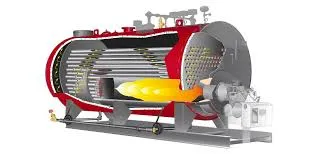
Déc . 26, 2024 11:15 Back to list
Exploring Innovative Designs for Efficient Steam Engine Boiler Systems and Their Applications
The Design of Steam Engine Boilers An Overview
Steam engine boilers play a crucial role in the generation of steam, which is essential for various applications, from powering locomotives to generating electricity in power plants. The design of these boilers is a critical factor that influences their efficiency, safety, and overall performance. In this article, we will explore the fundamental aspects of steam engine boiler design, focusing on their components, working principles, and considerations for optimizing performance and safety.
Introduction to Steam Boilers
A steam boiler is an apparatus that converts water into steam through the process of heating. This steam is then used for various purposes, such as powering engines, heating buildings, or driving turbines in power generation. The design of a steam boiler fundamentally revolves around two primary functions efficient heat transfer and safe containment of high-pressure steam.
Components of a Steam Boiler
Boilers consist of several key components that work together to ensure proper functioning
1. Furnace The furnace is where fuel is burned to generate heat. It must be designed to maximize combustion efficiency and control emissions. Common fuels include coal, natural gas, oil, and biomass.
2. Water Jacket Surrounding the furnace is the water jacket, which contains water that absorbs the heat generated. The design of the water jacket must ensure effective heat transfer to maximize steam production.
3. Steam Drum In many boiler designs, especially in large industrial boilers, a steam drum is used to separate steam from water. The steam drum allows for the collection of steam, which can then be channeled for use, while the water recirculates for further heating.
4. Superheater This component heats the steam produced beyond its saturation point, increasing its energy content and efficiency. Superheating is particularly important in steam turbines.
5. Economizer An economizer preheats the feedwater entering the boiler using flue gases, enhancing efficiency by reducing the amount of fuel needed to generate steam.
6. Safety Valves Safety is paramount in boiler design. Safety valves prevent excessive pressure buildup by releasing steam when necessary, ensuring safe operation.
Working Principles
The operation of a steam boiler involves several key steps
steam engine boiler design

1. Water Supply Water is supplied to the boiler and enters the water jacket.
2. Heating The fuel in the furnace is ignited, generating heat that transfers to the water, turning it into steam.
3. Steam Collection The generated steam rises to the steam drum, where it is separated from impurities.
4. Energy Utilization The steam can then be directed to turbines or other applications, where its thermal energy is converted into mechanical energy or used for heating.
Design Considerations
When designing a steam boiler, several critical factors must be considered to ensure safety and efficiency
1. Material Selection The materials used in boiler construction must withstand high temperatures and pressures. Commonly used materials include carbon steel and stainless steel, which offer durability and resistance to corrosion.
2. Thermal Efficiency The boiler design should minimize heat losses and maximize energy transfer. Features such as insulation, economizers, and superheaters are essential for improving thermal efficiency.
3. Pressure Ratings Boiler designs must meet specific pressure ratings to ensure safety under operational conditions. Compliance with regulations and standards, such as those set by the ASME (American Society of Mechanical Engineers), is essential.
4. Maintenance Accessibility Design considerations should include ease of access for maintenance and inspections. Regular maintenance is vital to ensure long-term safety and efficiency.
5. Environmental Impact With increasing regulations on emissions, designing boilers that minimize environmental impact is critical. Options such as low-NOx burners and advanced emission control systems can help meet these goals.
Conclusion
In summary, the design of steam engine boilers is a complex yet fascinating field that requires careful consideration of various factors, including component selection, working principles, and safety measures. As technology advances, boiler designs continue to evolve, becoming more efficient, safer, and environmentally friendly. Understanding these principles is essential for engineers and designers involved in the creation of systems that harness the power of steam for myriad applications, ensuring that steam boilers remain a vital component of modern technology.
-
High-Efficiency Commercial Oil Fired Steam Boiler for Industry
NewsJul.30,2025
-
High-Efficiency Biomass Fired Thermal Oil Boiler Solutions
NewsJul.30,2025
-
High Efficiency Gas Fired Thermal Oil Boiler for Industrial Heating
NewsJul.29,2025
-
High-Efficiency Gas Fired Hot Water Boiler for Sale – Reliable & Affordable
NewsJul.29,2025
-
High Efficiency Biomass Fired Hot Water Boiler for Industrial and Commercial Use
NewsJul.29,2025
-
High-Efficiency Biomass Fired Hot Water Boiler for Industrial Use
NewsJul.28,2025
Related PRODUCTS






















